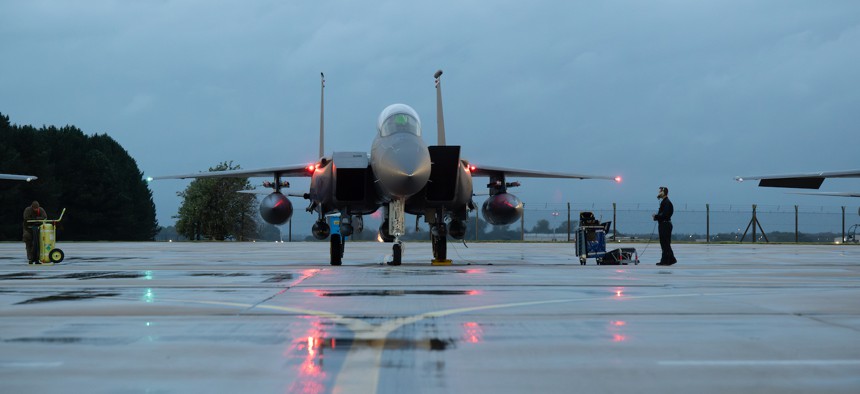
U.S. Air Force Airman 1st Class Smith Antone, 492nd Fighter Generation Squadron crew chief, conducts pre-flight checks of an F-15E Strike Eagle at RAF Lakenheath, England, during a deployment departure to an undisclosed location in Southwest Asia, Oct. 13, 2023. U.S. Air Force / Airman 1st Class Seleena Muhammad-Ali
New Air Force combat wings could deploy in 2 years
The service recently announced a major shakeup to prep for war with China.
The U.S. Air Force is planning to deploy its new “mission-ready” combat wings as soon as two years from now—as it carries out a massive overhaul to prepare for a fight in the Pacific.
The Air Force announced in February that it wants to restructure its wings so they train and deploy together. But before it can actually deploy the new structure, it needs ample time to practice, Air Force Chief of Staff Gen. David Allvin said during Defense One’s State of Defense series.
“We need to give them the time to have that training curriculum, to have the collective training, to have the certification, and then be able to go and deploy together,” Allvin said. An Air Force spokesperson later said these new combat wings wouldn’t be ready to deploy sooner than 2026.
This model is different from the way the service has operated in the past—deploying forces one squadron at a time and taking people and aircraft from various units throughout the service to meet in theater.
“We don't have a whole wing that picks up and trains together and understands each other in the deployed environment,” and that won’t work if the service has to be ready to fight “in very short order,” Allvin said.
The Air Force will start to identify which units will be the “deployable combat wings” in the coming months, and after they’re identified, they’ll start training together, he said.
“We are reorienting our wings to be able to train together as units in the environment practicing agile combat employment. That's where I think the airmen will really see it earliest, is when they start seeing [that] they’re training with the same units that they're going to deploy with, rather than meeting them up over in the theater,” Allvin said.
The restructuring of wings is one of many changes the service announced as part of an effort called “Reoptimizing for Great Power Competition.” The reorganization will be the most significant changes to the Air Force’s current structure in decades, as the service pivots away from the way it deployed forces to the Middle East to get ready for a bigger fight against China.
The service must start moving and be able to adjust on the fly, even though it might make some uncomfortable, Allvin said. There’s a “little angst” and confusion from Congress about the changes the Air Force is making, he said, so maintaining communication about the effort is crucial.
Lawmakers included language in the 2024 defense bill about the reoptimization effort, writing that the service hasn’t completely explained to Congress why the changes are necessary and what funds would be required to make those changes.
“We need to continue that communication and let them know that we may not know the exact heading of our destination, but we know plus/minus 15 degrees, and we're going to move out to get there. And those things will evolve, but we want to make sure we have the communication along the way. And when we start doing it within the next year or so, people will understand how we're doing it and why we're doing it,” Allvin said.
The service didn’t request funding in the fiscal 2024 or 2025 budget request for the reoptimization effort, but did include a few items on its “unfunded priorities list”—items the service didn’t fit into its $188.1 billion 2025 budget request—to help accelerate the reoptimization plan. This includes money for more exercises in the Pacific to practice the new deployment method and money to “reoptimize” the fighter force by buying parts and equipment to create nine new deployable “mission generation force elements.”
These “MGFEs” will provide combatant commanders with more options, Allvin said, because the same number of fighters can go to multiple locations with more sets of spare parts and kits.
“That's all this really is—readiness spare kits that allow you to take the same number of fighters, go to different places, and be able to operate from different places,” he said.




